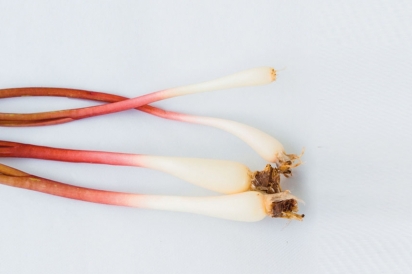A Guide To Eating Local: Ramps and Robins, It Must Be Spring!
A tiny harbinger of spring, the ramp pokes its leafy head out of the ground anytime from mid-March to early April, depending upon the region. Ramps, also known as wild leeks, are one of the first wild edibles to ripen every year. As soon as the winter’s snow disappears from sight, the plant makes a much-welcomed appearance.
In the South they are ready to harvest in March, while the rest of the country has to wait until April. The ramp is native to North America, its name coming from the word “rams,” or “ramson,” an Elizabethan term meaning wild garlic.
Ramps resemble the lily-of-the-valley. They usually have two or three bright green leaves which, when cut, or broken, give off the scent of garlic. A small white bulb, which grows below the surface of the soil, is attached to a stem with deep purple or burgundy tints. The entire plant is edible, and some folks opt to eat it raw. If this is your pleasure, here’s a word of advice: Ramps have a pungent onion flavor so you might want to avoid close contact with friends and family while snacking on these delights.
High in vitamins A and C, ramps may be effective in fighting colds and the flu. Ramps have the same capacity to reduce cholesterol as garlic. Mountain folk in Appalachia swear by their healing powers, and of course the plant’s strong smell lends to its odiferous reputation! Ramps are a member of the allium family, which includes onions, chives and leeks.
Over the last 20 years the demand for ramps has greatly increased. This is in part due to cooking shows and upscale foodie magazines, which have extolled the culinary delights of this plant. Chefs in big cities such as New York have given this Allium tricoccum star status on their menus and in their kitchens, thus increasing its popularity and worth.
Many people enjoy harvesting their own supply of ramps, using them in their home kitchens or selling them to restaurants, stores and at farmers’ markets. If you are interested in gathering your own ramps, here are a few helpful hints. Ramps like forested terrain that is shady and sandy. When looking for them, keep in mind that they are often found near rivers and streams since they like moisture. They often grow on the north side of embankments in small clumps. Tear off a leaf and you will be sure to recognize the ramp by its distinctive onion, garlicky smell. Remember to always positively identify any wild edible before ingesting it.
After harvesting, be sure to use your ramps quickly. The leaves can be refrigerated and will last for three to four days before they begin to wilt. The leaves have more garlic and onion flavor than the bulb. Ramps can be used in place of onions and garlic, just keep in mind that they are considerably stronger in taste so use a smaller amount when cooking. They may be added raw to salads or sandwiches, or sautéed in soups, sauces, burgers, scrambled eggs and omelets. Their uses are varied and depend upon the cook’s personal preferences and creativity.
The arrival of the ramp is cause for celebration in some areas. In the mountains of West Virginia there are festivals and events,which have been held for generations. Whole towns get together to cook up batches of ramps in various forms using time-honored recipes, celebrating its long awaited arrival with feasting and dancing.
There is concern in some circles that ramps may be over-harvested. As harvesters collect ever-growing quantities for big city restaurants, some wonder about economics versus sustainability. It takes six to 18 months for ramp seeds to germinate, while the plant needs five to seven years to produce seeds. In some areas such as Great Smoky Mountains National Park in North Carolina and Tennessee, ramp harvesting was banned in 2004, and in Quebec its sale has been banned since 1995. There the plant is labeled a “vulnerable” species.
It has been noted that folks either like ramps or hate them, but whatever the case their arrival heralds the beginning of spring and the end of another long, cold winter. As the robin greets us, so does the ramp, the tips of its leaves poking through the sun-warmed soil announcing to the world that spring has arrived at last!






